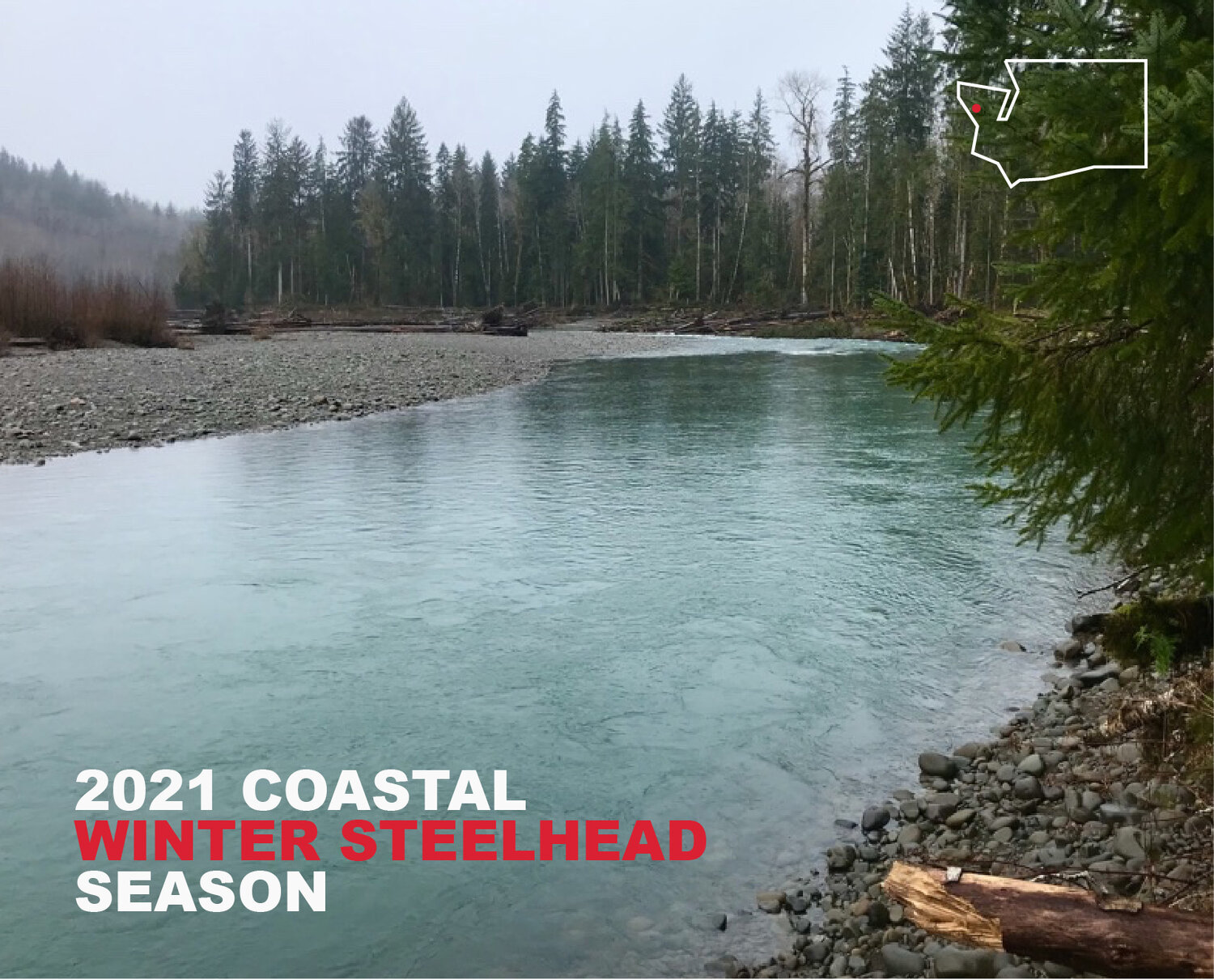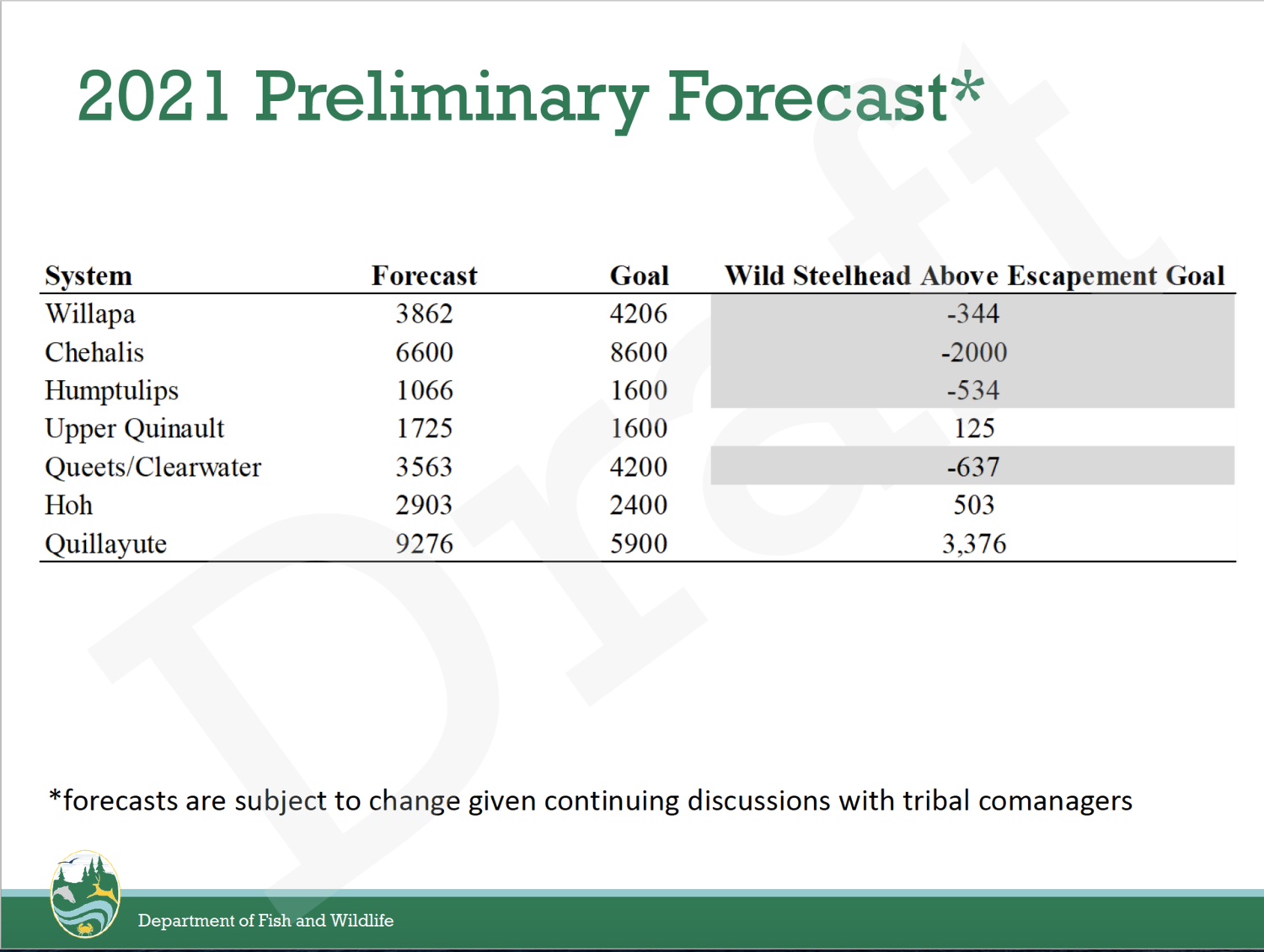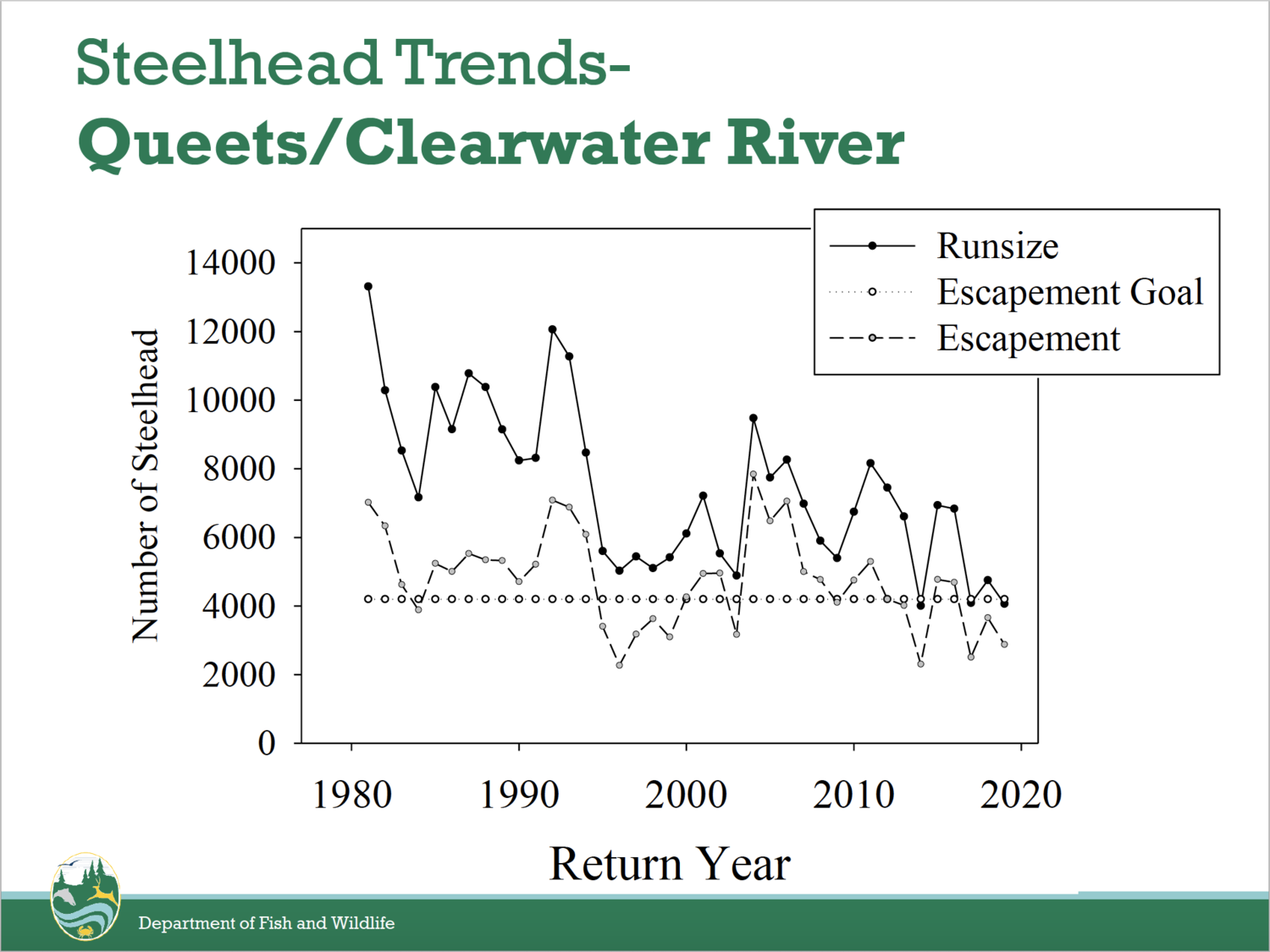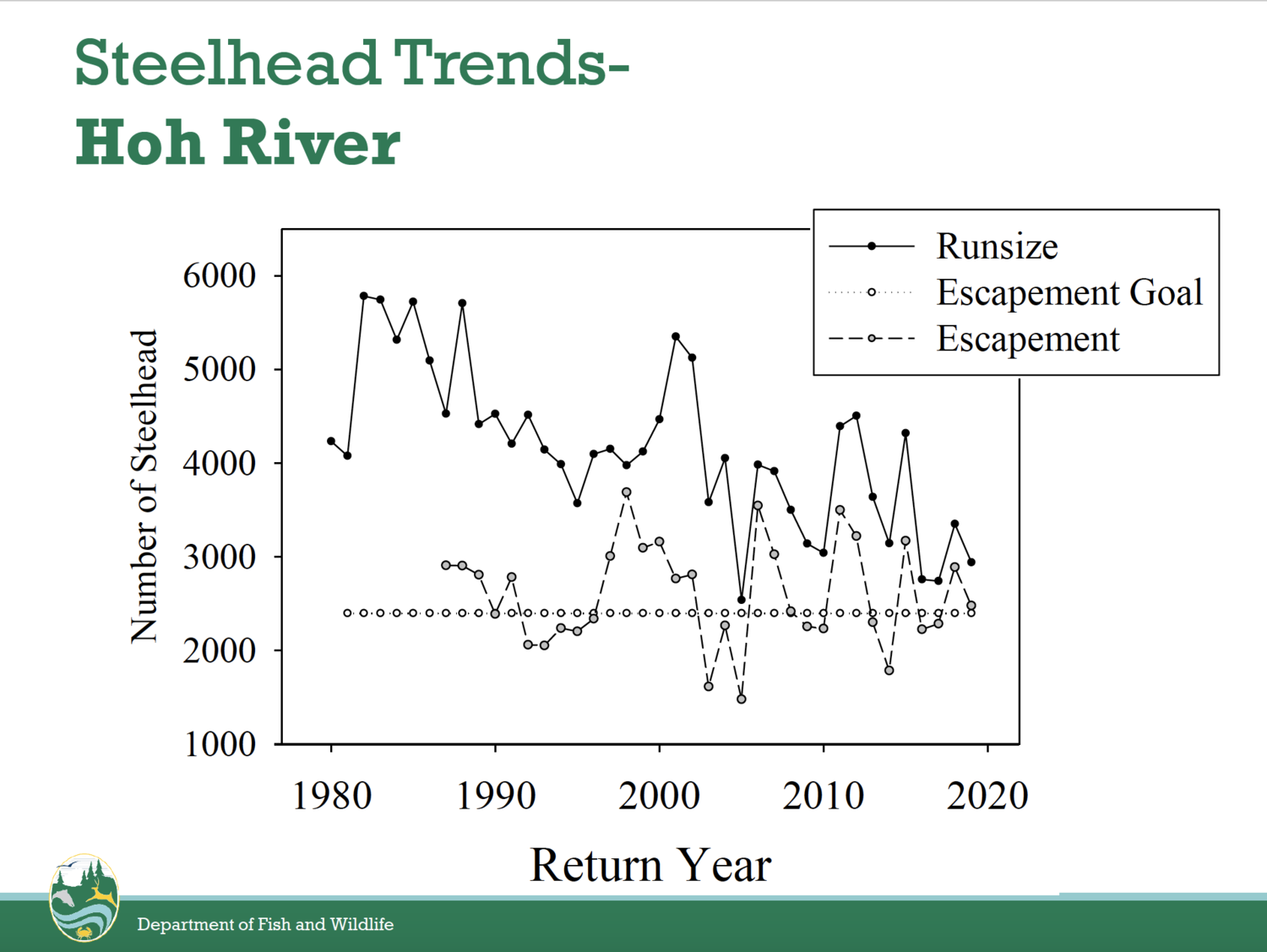
In an online meeting on Tuesday evening, Washington anglers heard updates from state fishery managers on projected wild winter steelhead run numbers and potential regulatory options for the upcoming winter angling season on Washington’s coastal rivers.
Broadly speaking, the news continues to be grim. Years of population declines, exacerbated by recent downturns in ocean productivity and survival, have continued. With a few notable exceptions, steelhead numbers are struggling across coastal watersheds. Anglers can, and should, expect less opportunity to fish on these rivers during the Winter and Spring of 2021.
According to Washington Department of Fish and Wildlife (WDFW) data, the Chehalis River is expected to miss escapement requirements again, as are the rivers of Willapa Bay and the Humptulips. The Queets River continues to falter and will miss escapement goals again this year by a substantial amount. The Upper Quinault and the Hoh Rivers are projected to just barely meet spawning requirements. The Hoh has missed escapement many times in recent years and hopefully this year’s projection remains accurate at the end of the season.
In the meeting, the Quillayute system was celebrated as a bright spot among coastal runs, but not every tributary of the river is performing equally. Fish numbers on the Sol Duc (Washington’s first river protected as a Wild Gene Bank in 2012) seems to be holding relatively steady. The Calawah and Dickey have consistently met escapement goals. The Bogachiel, despite its popularity, especially among fly anglers, has seen its runs falter during recent seasons. It missed escapement goals in 2016, 2017 and 2019. In 2016, only 730 fish were recorded.

Angling Options
In response to these poor pre-season run projections and the acknowledged need to protect diminished wild fish stocks, WDFW managers outlined four possible frameworks for the upcoming winter steelhead sportfishing season on the coast. Attendees had an hour to offer feedback on the proposed options while WDFW employees answered questions.
In Option One, the season across all coastal watersheds would close early. The department suggested March 1 as a possible date for closure. This would provide a few months of the season, allow anglers to target early-returning hatchery fish where they are present, and protect the majority of the wild fish run which typically peaks in March now that the early returning wild fish are such a diminished population.
In Option Two, because of the relatively strong returns to portions of the system, only the rivers of the Quillayute would be open during the upcoming season. All other watersheds on the coast would be closed.
In Option Three, the season would run to the same dates as recent years, but with additional regulations for fishing methods. WDFW suggested that this could potentially include bans on the use of bait where it is currently allowed, limits on the harvest of resident rainbow trout, and an expansion of waters where anglers would not be allowed to fish from floating devices. In these sections of water, boats and rafts would be for transportation only, similar to current rules in place on the Upper Hoh.
In Option Four, all angling on the coast would close from December 1, 2020 through April 15, 2021 to protect stocks with projected low returns and prevent outsized impact from increased angling pressure on any river that would have otherwise remained open.
All of these options have pros and cons for both angling opportunity and wild steelhead protection. After hearing from the public, WDFW now heads back to negotiations with Tribal Co-Managers to make final decisions to establish the upcoming seasons. They’ll need to weigh a complex mix of factors, including the need to protect wild steelhead diversity and spawning productivity, the importance of harvesting hatchery fish to prevent interbreeding with wild fish, how angling methods might limit impact on migrating and holding fish while still providing opportunity for a majority of anglers, the economic impacts of river closures to rural communities, anticipated movement of anglers and guides seeking open rivers if their first choice is closed, and the harvest and conservation goals of the tribes.
WDFW representatives indicated that the four outlined options are a starting point for consideration and not rigid categories for how the upcoming season will proceed. The final plan could include various combinations and elements of the four presented options as the details are decided.
Like many anglers and conservationists deeply concerned about the future of wild steelhead in Washington’s rivers, the Wild Steelhead Coalition will be waiting to hear and evaluate how the department opts to proceed this Winter.
In the meantime, anglers interested in learning more can review the department’s presentation materials on run size projections and angling options and/or watch a recording of the meeting here:
https://wdfw.wa.gov/get-involved/calendar/event/coastal-steelhead-virtual-town-hall

The Need to Change Course
The fact is, the management status quo is failing on the majority of Washington coastal wild steelhead watersheds. Every year there are more anglers and fewer fish.
We respect the complex situation, obligations to stakeholders, and budget constraints managers face on the coast. The opportunity for the public to hear about steelhead numbers, ocean conditions, and fishery concerns directly from WDFW representatives is always helpful, instructive, and critical for building trust. But it is clear that a new management paradigm, one that prioritizes wild steelhead abundance, must be implemented immediately. Anglers, tribes, and fishery managers cannot simply continue business-as-usual as these incredible watersheds continue to miss escapement goals and suffer declines year after year. We know how this trajectory ends and it is unacceptable.
Fortunately, the coastal watersheds of Washington still provide an exceptional opportunity to change course. These rivers still have salvageable populations of wild steelhead returning and relatively intact habitat, especially where it has been permanently protected in the Olympic National Park. Logging practices are better than they were in the past. Removing culverts and other barriers can reconnect important wild steelhead and salmon spawning and rearing habitat that has been cut off for years. The wild fish have demonstrated their resilience time and time again, we just need to give them a chance. If we commit to prioritizing escapement goals above else each year, and even raise those crucial requirements, the wild fish will utilize the available habitat, restore diversity within their populations, and rebuild their numbers. They are fighting to do so now, we just need to give them room to survive.
Simply put: We need more wild fish spawning successfully.
This work will require difficult decisions in the short term, long term commitments from fishery managers to prioritize wild abundance, and the support of all types of anglers.
In the short term, emergency closures and reductions to angling impacts must be enacted on a river by river basis. These steps must be comprehensive and impactful enough to provide serious benefits to wild steelhead stocks. The time for small gestures is long past.
This is painful when it closes rivers to sport fishing, but this is the most democratic regulatory option because it affects all anglers equally. For better or worse, it is also the easiest to enforce. When watersheds are projected to miss escapement goals, it is crucial these populations are given a chance to stabilize. Members of the Wild Steelhead Coalition love steelhead fishing and it pains us as much as anyone to not be able to fish a river like the Queets, the Hoh, or the rivers in the Chehalis system, but we understand how important it is to give the fish a break when and where these populations are dangerously low and losing ground year after year. The fact is, that even though sport fishing is only one factor originally causing the decline of wild steelhead on the coast, we can’t let it be the straw that breaks the camel’s back during years of low returns.
We have to be prepared for some sacrifice. Perhaps, wherever a river hovers near escapement numbers, anglers could accept some limits on fishing from floating devices in the upper sections of more watersheds and/or shorter seasons because we understand how important it is to provide in-river sanctuary to steelhead waiting to spawn after they’ve run the downstream gauntlet of anglers and gillnets.
The fish that are caught must be celebrated, but handled carefully to ensure survival. It is illegal to lift a wild steelhead out of the water in Washington, but keeping the gills submerged and flushed with water should be emphasized and required, especially during years of low returns when survival is more important than ever. We need every fish to make it to the spawning gravel.
We know anglers need to limit the number of fish we catch and release while their stocks are allowed to rebuild. We believe most anglers recognize this fact when push comes to shove and that it is the responsibility of managers to state these goals clearly and make the tough decisions to act on behalf of restoration. It is their job to ensure a future for wild steelhead on Washington’s coastal watersheds and it is our job to make sure they take the necessary steps.
We need to act now, and accept some limitations in the short term, in order to regain full seasons and access to healthy, sustainable populations of wild steelhead as soon as possible. What we do today will impact upcoming seasons, especially during these years affected by poor ocean conditions.
In the long term, sustainably managing the rivers of the Olympic Peninsula and Washington Coast – or any wild steelhead river for that matter – will come down to our collective willingness to take responsibility for these fish and watersheds before it is too late.
Managers must build a new regime that properly balances angling opportunity with a proactive, conservative emphasis on consistently meeting rigorous escapement goals. Each watershed must be managed according to its unique characteristics. For example, the Bogachiel requires separate regimes from the Sol Duc and the amount of water open or closed on the Hoh must be determined separately from decisions about the Queets or Humptulips.
The Washington Coast could, and should, be a beacon for responsible fishery management in the 21st Century. These fisheries, if managed well, could provide opportunity for recreational anglers, harvest for the tribes, and support rural economies for generations to come. We should aspire to nothing less and the steps should begin immediately.
It is hard to say exactly what mix of practices and regulations will provide the precise management required in the long term. Undoubtedly, reinstating a group like the North Coast Advisory Group to provide a forum for scientific and angling policy to help guide fisheries on the coast is an important step. A representative group of stakeholders with shared goals and a clear framework for policy implementation would build consensus among the angling community around forward-looking, sustainable management.
Given the precariousness of wild steelhead runs, a stakeholder group could evaluate a range of possible management options. Among anglers and advocates, we often hear combinations of these options discussed and suggested:
- Seasonal closures on upper reaches of watersheds when flows are low or low run projections mean sanctuary is required for resting and spawning fish
- Expansion of Wild Gene Bank Protections
- Regulate the number of guides operating on the rivers, especially those from outside the region
- Consider a system regulating daily numbers of anglers or boats on popular rivers during peak seasons (Perhaps modelled on deer and elk hunting management?)
- Limits on the number of fish caught and released by individual anglers on a daily or seasonal basis
- An additional Coast Watershed Endorsement to raise funds for expanded law enforcement to prevent poaching
- Improve monitoring with the use of sonar to provide real-time run counts, better information for forecasting models, and to guide in-season openings and closures
- Prioritize and complete the most impactful habitat restoration projects
- Advocate for Washington to raise the costs of visiting angler licenses and out-of-state guide permits for much needed funding
- Consider permanent bans on bait or other angling regulations
To be clear: We don’t know exactly which combination of interventions will prove most effective, or politically expedient, but we believe stakeholders need a formal forum for these tough conversations with fishery managers and, together, build a better path forward. The status quo now on the coast is a crowded free-for-all where the fish, and the anglers, all lose as run numbers continue to decline year after year.
A path towards recovery and fair access to these amazing public fisheries is required for long term viability.

Looking Ahead
The wild steelhead rivers of Washington’s Coast and Olympic Peninsula are a treasure and must be treated as such. They are a fundamental element of the region’s ecology, culture and rural communities and their tragic decline must be stopped and reversed now, while we still have the chance.
The Wild Steelhead Coalition is deeply committed to these watersheds. We fought for regulations to keep wild steelhead in the water and prevent their intentional harvest in recreational fisheries. We worked to establish the Sol Duc River as Washington’s first Wild Steelhead Gene Bank. We have donated a raft and game cameras to support WDFW Law Enforcement officers on the Olympic Peninsula. We are part of a broad coalition working to stop a misguided dam from being built on the Upper Chehalis Watershed. We have been tracking trend lines for the coastal streams for years and last spring we spoke out for the need to find a new direction for the Olympic Peninsula’s iconic rivers before they slip into a state of decline that requires intervention through the Endangered Species Act.
This moment, while we wait for WDFW fishery managers to announce the parameters of the upcoming winter’s steelhead season on the coast, is a continuation of this work. This is a critical time for the watersheds and wild steelhead of Washington’s coast. It is one anglers must meet as a unified force. Along with the tribes, we are the people who care the most about these watersheds and fish. It doesn’t matter if you’re an angler who loves to swing flies, drift beads, pull plugs, or chuck spoons. As our co-founder Rich Simms reminds us: we all carry a cork. Every angler on the coast wants the same thing: more steelhead entering the rivers and reaching the spawning grounds each year.
Together, we must tell our lawmakers, leaders and fishery managers that we are willing to make sacrifices, and we will support difficult decisions, but we won’t accept anything less than healthy wild steelhead runs on these exceptional watersheds.
This post brought to you by the Wild Steelhead Coalition. Support them and their efforts on behalf of wild fish.
| As a small, grassroots nonprofit organization, our work depends on the support of our members and fellow anglers. Your gift from 2019 and/or during 2020 has helped us advocate for wild steelhead protection and restoration, and the rivers they depend upon, across their native range. Thank you for your support. With the spread of the Covid-19 pandemic, 2020 has been a challenging year for many businesses and conservation groups. We especially miss hosting in-person events with our members and other wild steelhead advocates and look forward to getting back to these gatherings as soon as possible. At least when we are fishing, it is easy to physically distance on the river! Despite the challenges, the last year has been productive for the Wild Steelhead Coalition. With the help of WSC members, we have successfully stalled the dam proposed on the upper Chehalis River, fought against fish farms in Puget Sound, participated in the Puget Sound Steelhead Advisory Group, and equipped the Washington Fish and Wildlife Law Enforcement team on the Olympic Peninsula with game cameras and a new raft they are using to catch poachers and protect imperiled wild fish runs. You may have noticed, but we also launched a new website and updated our Adipose newsletter and email system. These improved platforms are better enabling us to amplify our message, empower anglers to take action for wild steelhead and the rivers they depend upon, and educate the public on the importance of these iconic fish. |
| Check Out the Wild Steelhead Coalition’s New Website |
| While we are proud of our success, it is clear wild steelhead need our help more than ever. Looming potential closures and missed escapement goals during this winter’s run on the Olympic Peninsula – an ecosystem we call the Last Great Place – demonstrate the dire situation facing wild steelhead. This situation illuminates a fundamental truth that guides our organization: no one cares for these fish and their natal waters as much as anglers, and it is our responsibility to fight for their future. Thank you for stepping up and fighting for Wild Steelhead. Your support is critical to fueling our community’s work to protect and restore our wild steelhead runs before it is too late. We couldn’t do it without you. – Greg Topf, WSC Board Chair |

